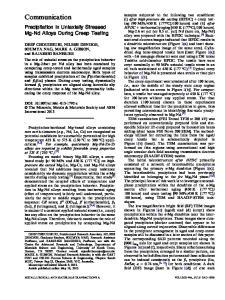Coil Relaxation in Uniaxially Deformed Polymer Melt
- PDF / 210,819 Bytes
- 4 Pages / 420.48 x 639 pts Page_size
- 70 Downloads / 265 Views
COIL RELAXATION IN UNIAXIALLY DEFORMED POLYMER MELT
KELL MORTENSEN*, OLE KRAMER**, WALTHER BATSBERG* AND L.J. FETTERS*** *Risp National Laboratory, DK-4000 Roskilde, Denmark **University of Copenhagen, DK-2100 Copenhagen, Denmark ***Exxon Research and Eng. Co., Annandale, NJ 08801, U.S.A.
ABSTRACT SANS studies on the relaxation of an amorphous polymer melt is reported. Just after the uniaxial elongation the chains deform affinely. Shortly thereafter the SANS results give evidence of chain contraction. Some randomization is observed long before the reptation time is reached.
INTRODUCTION The viscoelastic properties of highly entangled polymer melts have resently attracted a lot of interest. Doi and Edwards (DE) published in 1978 an extended theory, which based, on the "tube model", describes the relaxation after a step strain [i]. The relaxation involves three processes. The first process is a very fast equilibration of chain segments between entanglements. This process will be disregarded in the following. In the second process the chains recover their equilibrium curvilinear length by retraction inside the tube. The longest relaxation process is the reptation process originally introduced by de Gennes [2]. Both relaxation processes depend on the molecular weight, M. If M is sufficiently large, the two mechanisms are well separated in time, and each process should appear in a study of the radius of gyration tensor. Small angle neutron scattering is an ideal tool for such study. Boug et al. have already made extensive SANS studies on polystyrene, however, without succeeding in discrimination between the relaxation processes. In the following we present extended analysis of results obtained on a poly(ethylethylene-co-ethylene) melt [4]. The results are in qualitative agreement with the DE-predictions.
EXPERIMENTAL For the study we have used a sample of 2M-Dalton poly(ethylethyleneco-ethylene) with 2% of the molecules having 2 out of 8 hydrogens substituted with deuterium. This very dilute deuterium marking prevents phase demixing as observed for high concentration blends [5]. The polymer film was stretched by a factor of 3. Neutron scattering was performed at the SANS facility at Riso National Laboratory using a neutron wavelength X = 1.5 nm.
RESULTS AND DISCUSSION Fig. 1 shows contour plots of scattered intensities for the unstretched, uniform sample and for the stretched sample relaxed 300 sec at Tg + 8 K. It appears that the uniform sample shows circular symmetry, whereas the stretched polymer shows elliptical contour levels. For all spectra obtained on the relaxed sample, constant intensity levels fit very well to ellipses, and the eccentricities, e, are within the statistics constant in the measured q-range. In Fig. 3b is shown the values of e = RI/R, versus time. The errorbars of Fig. 3b gives the statistical
Mat. Res. Soc. Symp. Proc. Vol. 79.
1987 Materials Research Society
260
S
Li
Li
0.2
0.2,
°-°
"o
aI-'
S
-02
(a)
-0.2
(b)
U,
-0.2
QO
02
-0.2
QO
0.2
SCATTERING VECTOR. qL(nm"' Fi
Data Loading...











